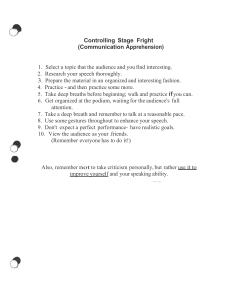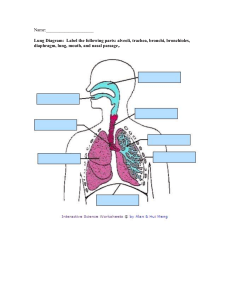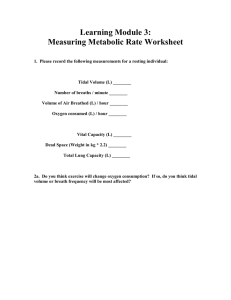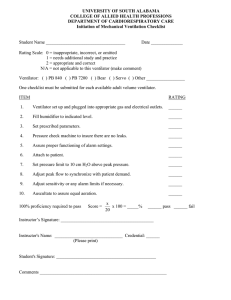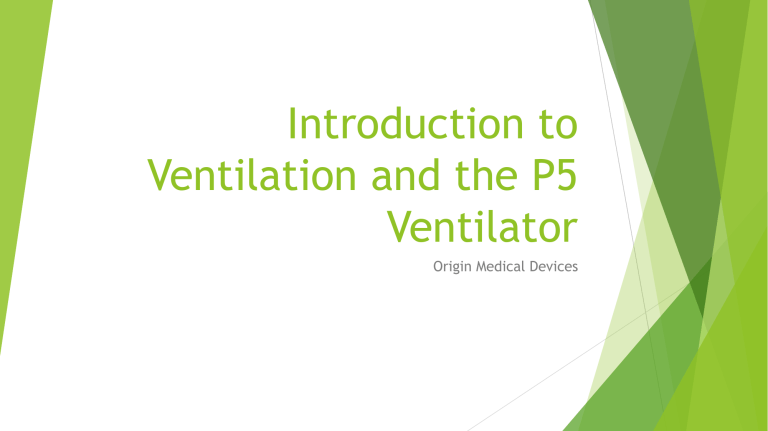
Introduction to Ventilation and the P5 Ventilator Origin Medical Devices Ventilation Basics What is a Ventilator? A ventilator is a machine used to assist breathing. Think of it as a lung outside of the body Ventilators are used to take care of patients from than .3kg to >200kg This machine has different modes and settings based on the patient. The patient Since we aren’t working in the hospital our patient is the test lung. We have 4 different types of test lungs. The blue Ingmar lung –easily portable, can adjust compliance The plastic(bottle shaped) static compliance test lungs-portable and cannot adjust compliance The TTL –not very portable, you can adjust compliance, most reliable for reproducing test cases The ASL 5000- not very portable, can run automated and simulated test cases. Can adjust compliance, trigger breaths and more. Compliance What exactly is compliance? Lung compliance, or pulmonary compliance, is a measure of the lung's ability to stretch and expand. The lower the compliance the stiffer or smaller the lung. Lung compliance can be measured in ml/cmH20. Resistance Resistance represents the airway and is variable. We have a set of fixed parabolic resistors from a resistance of 5 to a resistance of 500 When setting up test cases you will have to pay attention to what the resistance and compliance settings. These will be called “test lung settings” There are two types of resistors – parabolic and Linear. The Linear ones simulate the patient better but are cannot be used with humidifiers and are very expensive. We normally use parabolic which actually makes it harder on the vent to control flows and pressures Ventilator Settings Now that we know what the “test lung settings” are we need to learn what “Ventilator settings” are and how they are used. There are different settings for each mode and breath type. These settings vary depending on the patient, or in our case what patient we are trying to ventilate. Ventilator Settings Cont. Respiratory Rate(RR)-how many breaths will be delivered within 1 min. Tidal Volume (Vt)- how much air will be delivered to the patient for every Positive End Expiratory Pressure(PEEP)- this is the new baseline for O2% (FiO2)- This is the fraction of inspired oxygen delivered to the patient Inspiratory Time(Ti)- This is how long the delivery of flow to the patient breath. pressure to be maintained between breaths, measured at the end of exhalation. A set pressure applied by the ventilator at the end of each breath to ensure that the lung or test lung does not collapse. during ventilation. This ranges from 21% which is room air(no oxygen added) to 100% which is pure O2 will take place. Ventilator Modes and Breath Types ACMV-Assist Control Mandatory Ventilation VC- Volume control PC-Pressure Control PRVC-Pressure Regulated Volume Control SIMV-Spontaneous Intermittent Mandatory Ventilation VC with VS- Volume Control With Volume Support PC with PS- Pressure Control With Pressure Support PRVC with VS- Pressure Regulated Volume Control With Pressure Support SPONT-Spontaneous Mode PS- Pressure Support VS- Volume Support SMART VC with VS- Volume Control With Volume Support PC with PS- Pressure Control With Pressure Support PRVC with VS- Pressure Regulated Volume Control With Pressure Support BILEVEL ACMV-Assist Control Mandatory Ventilation MODE: ACMV- This mode means that the ventilator is delivering a set number of breaths per minute that will be delivered no matter what. VC: User sets Tidal volume(Vt). Volume of gas in ml to be delivered to the lung. PC: The opposite of volume control. The user sets the pressure that they want to be at the wye and the tidal volume does not matter. PRVC-Pressure Regulated Volume Control: Pressure is adjusted up or down in order to deliver target Vt VC- Volume control The user defines the amount of gas (Vt) that has to be delivered to the patients lung and how fast. The ventilator does this regardless of the Resistance or Compliance of the lung. The pressure measured at the wye will be affected by the compliance and resistance of the lung or test lung. User sets RR, Vt, Ti, FIO2, PEEP PC-Pressure Control The opposite of volume control. User sets the pressure (measured at the wye) that will define when the inspiratory phase will end. Actual Vt will vary depending on resistance and compliance. PRVC-Pressure regulated volume control This is special mode where the ventilator provides a pressure waveform similar to pressure control but instead of using the set pressure as the control parameter, it uses the set tidal volume as a target. The ventilator will monitor the delivered tidal volume and adjust the pressure on a breath by breath basis in order to reach the target Tidal Volume. SIMV-Spontaneous Intermittent Mandatory Ventilation SIMV- the ventilator enables a combination of mandatory breaths as well as spontaneous breaths. The user can set a mandatory rate and support level(PS or VS) that will be used for any breaths triggered above the set mandatory rate. The settings of the mandatory breath as well as the spontaneous breaths are controlled by their own respective settings (Ti, expiratory threshold, target pressure etc…). A “time window” is calculated as 60/Rate SPONT-Spontaneous In this mode, the ventilator does not generate any mandatory breaths and only generates spontaneous breaths based on the type and setting selected (SPONT/VS/PS). If the rate falls below the APNEA interval, the ventilator will enter apnea backup ventilation. When backup ventilation is terminated, the ventilator will return to the previous mode. Volume support- this mode is similar to PRVC except that it is a spontaneous breath and not a mandatory one. Therefore the target pressure is set to achieve the set volume however, the termination criteria is not the defined Ti for PRVC rather similar to the criteria for PSV. Pressure Support-Pressure Support Ventilation -PSV is similar to PCV expect for its termination criteria. In PCV, the breath is terminated based on the defined inspiratory time, Ti. SMART SMART mode promotes spontaneous breaths. Like in SIMV, the user sets the mandatory breath type and settings as well as the spontaneous breath settings. The user also sets the rate and an additional setting specific to the SMART mode which is the smart time window. In SMART mode, as long as the patient triggered breaths are at intervals shorter than the time window, the breaths will be spontaneous and the rate setting will not be used. However, if the time window elapses, the ventilator will generate mandatory breaths at the specified rate. Once the patient generates a breath, the ventilator will fall back into the spontaneous only mode and will stop delivering mandatory breaths. BiLevel In Bi-LEVEL the ventilator switches between two levels of PEEP based on the definition of the timing and the levels. For example, if the settings are the low pressure of 5 cmH2O, the high pressure 10 cmH2O and the timing for the low pressure is 4 seconds and the high pressure 2 seconds, then we would have 4 seconds at 5 cmH2O and then 2 seconds and 10 cmH2O. During both levels the patient can trigger spontaneous breaths at the level defined in the settings. It is not possible to activate NIV and Leak compensation in bi-LEVEL mode. Waveforms Controlled breath delivery parameters: PRESSURE in the lungs Inspiratory Expiratory FLOW during breath delivery Inspiratory Flowrate Flow pattern VOLUME delivered to the lungs Inspired 17 | Breaths: How They Start and Stop TRIGGER: how the delivered breath is initiated • Patient triggered • • Pressure trigger • Flow trigger • SMART Trigger Ventilator triggered • Time trigger CYCLE: how the delivered breath is terminated • Time Cycled • Flow Cycled • Volume Cycled 18 | How Waveforms Look In Different Modes Ventilator Mode: WHEN the ventilator delivers a breath Assist/ Control: every breath is a “mandatory” positive pressure breath P SPONT: All breathing is spontaneous. NO “mandatory” positive pressure breaths. P SIMV: intermittent “mandatory” breaths with spontaneous breathing between P 19 | Setting Layout in Different Modes Volume Control Pressure Support Pressure Control SIMV 20 | Ventilator Alarms Additional Patient Alarms: Disconnect Occlusion Apnea 21 | User Adjustable Alarm Settings: High Peak Pressure (High PPEAK, HIP): visual and audible alarms when lung pressure reaches set level. Also terminates inspiration at alarm to further protect patient. Respiratory Rate ( RATE): visual and audible alarms when total measured respiratory rate exceeds set level. Total Exhaled Minute Volume (High VE, Low VE): visual and audible alarms when measured total exhaled minute volume is higher or lower than set levels Mandatory Exhaled Tidal Volume (High VTE MAND, Low VTE MAND): visual and audible alarms when measured exhaled tidal volume for mandatory breaths is higher or lower than set levels Spontaneous Exhaled Tidal Volume (High VTE SPONT, Low VTE SPONT): visual and audible alarms when measured exhaled tidal volume for spontaneous breaths is higher or lower than set levels Common Alarms to Pay Attention To High Peak pressure Alarm Circuit Open Alarm High Rate Alarm High Minute Volume Alarm O2 alarms High O2 Alarm Low O2 Alarm No O2 Alarm Anatomy of a Circuit Inspiratory Limb Expiratory limb Humidifier Wye Questions?
